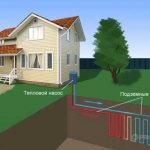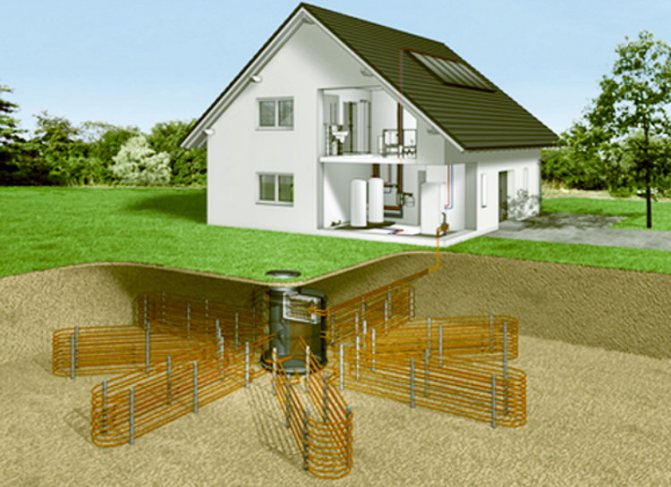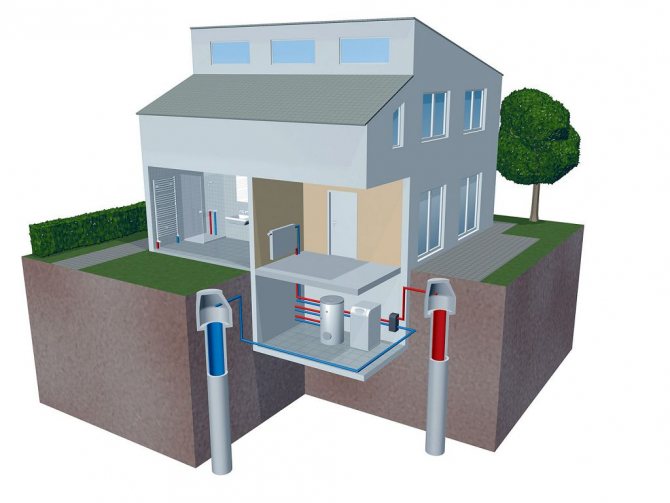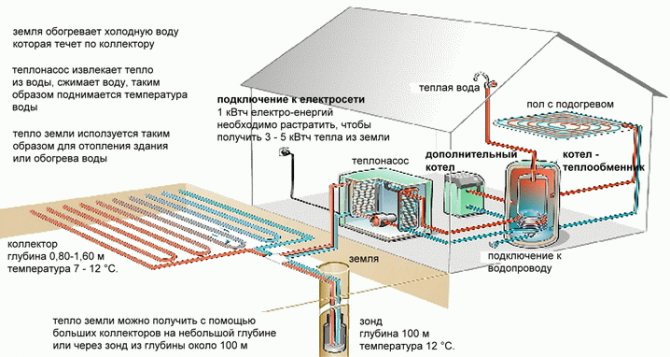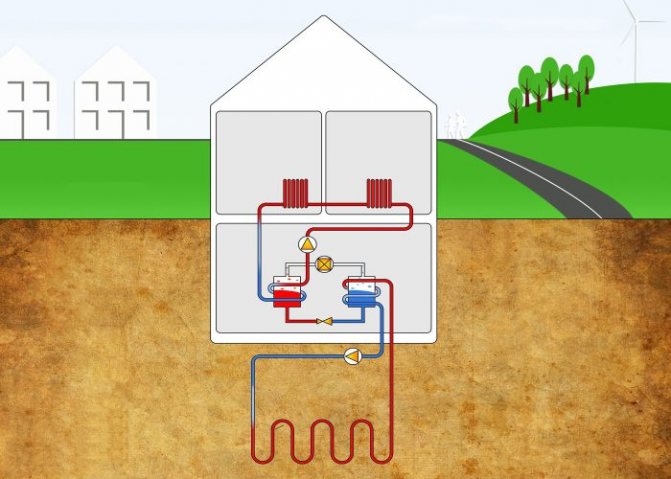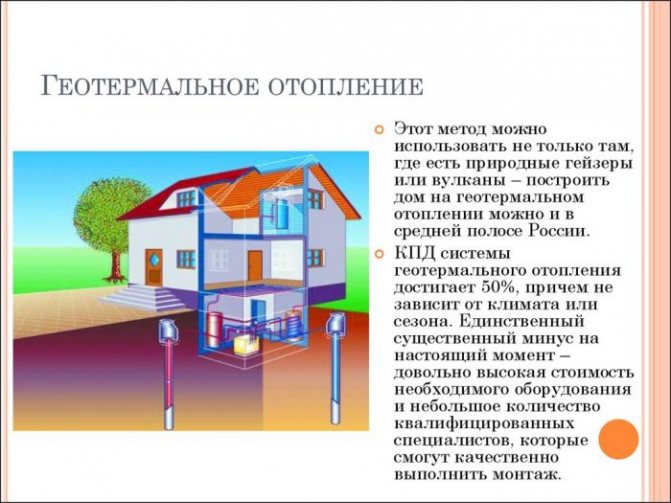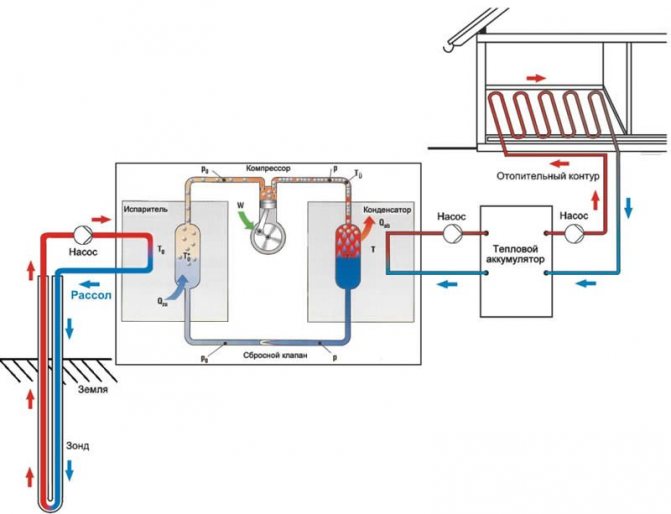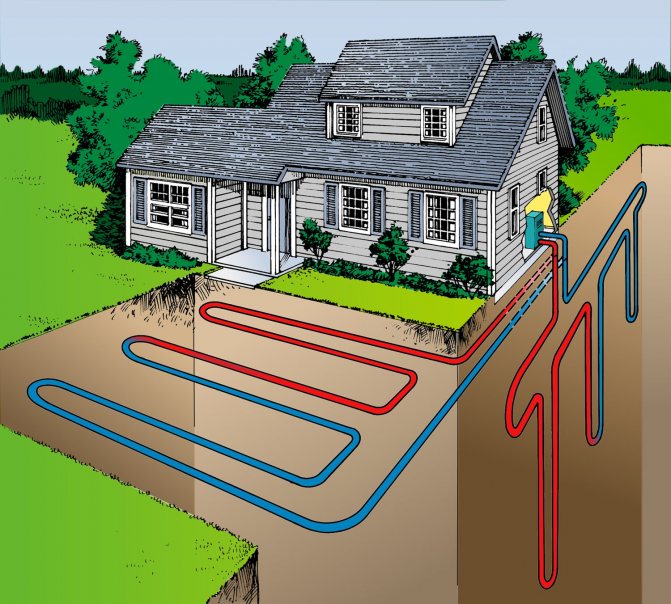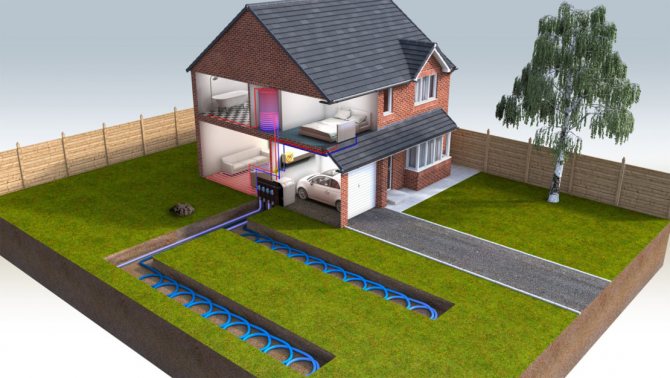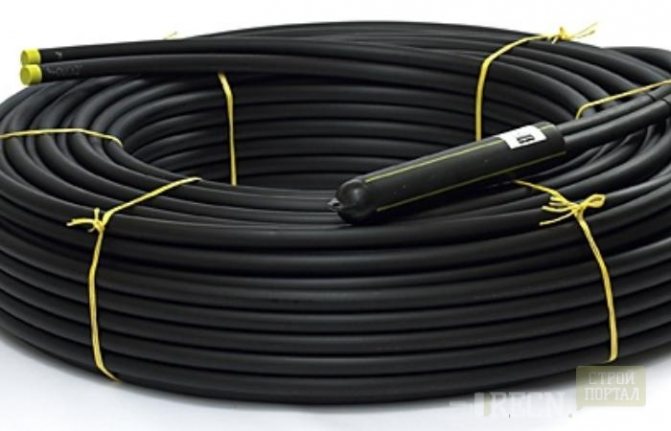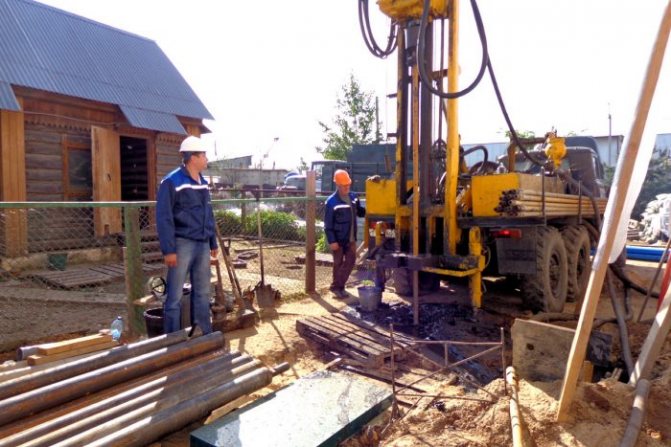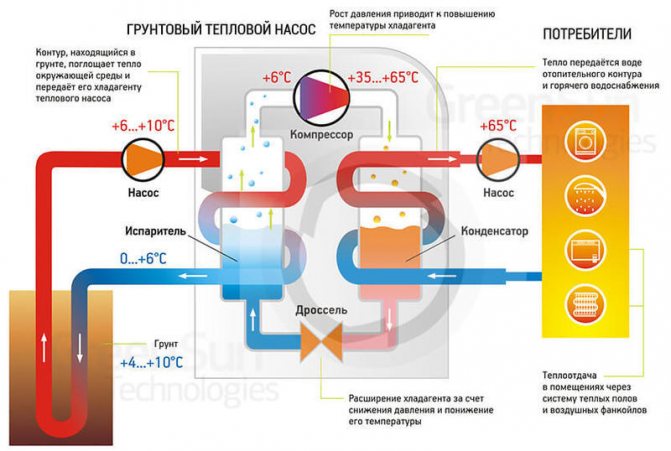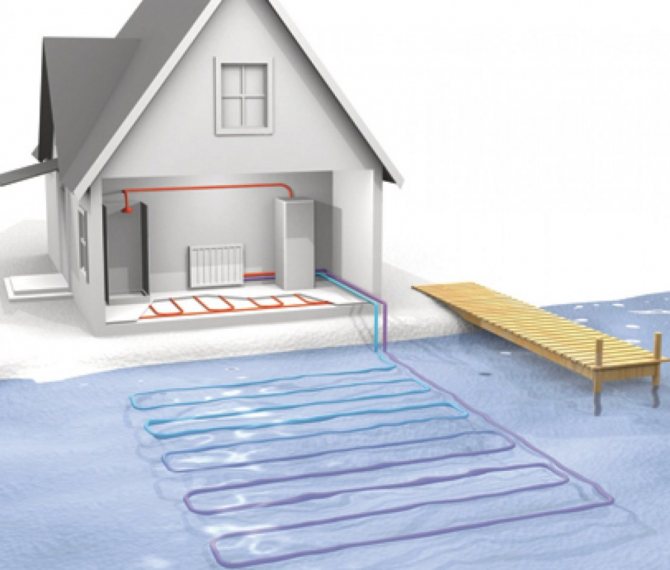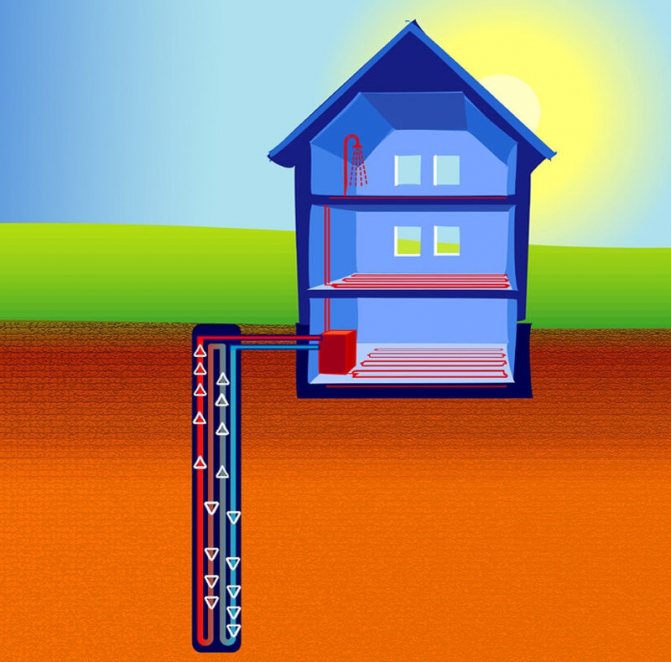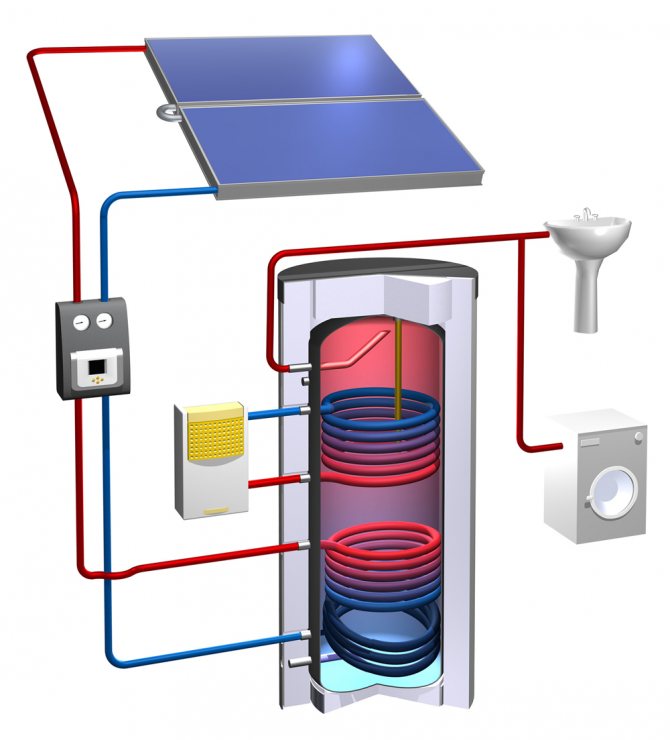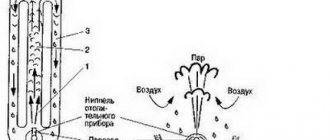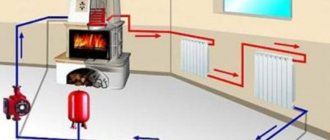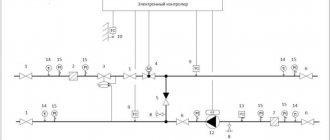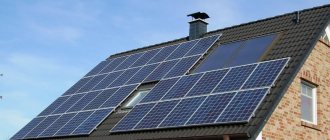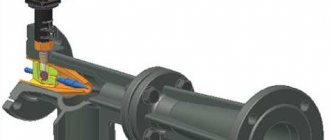To provide a private house with heat, units that run on electricity, solid, gas or liquid fuels are traditionally used. In recent decades, solar collectors and the heat of the earth's interior have been used as an alternative source of thermal energy. Heating a home with the heat of the earth is called geothermal home heating.
Geothermal heating of the house using the energy of the earth
Heating from the ground is in growing demand, as the cost of conventional energy sources steadily increases, while the reserves of fossil fuels are decreasing. Investing money in earthen heating of a country cottage is quite profitable, taking into account the economic prospects and significant savings on autonomous heat supply during the heating season.
Methods for obtaining natural thermal energy
Ground source heat pumps differ in the way they extract heat:
- Installations that use the heat of deep groundwater, hot geysers, etc.
- Systems that include an antifreeze tank installed in the ground at a depth of 75 meters. Heating from the bowels of the earth is provided by natural heating of the tank with antifreeze; As a result, the refrigerant, passing through the heat exchanger, gives up the received heat and returns to the container.
- The geothermal circuit is laid along the bottom of the reservoir, which is a natural heat accumulator. In this case, you need to take into account that the reservoir can completely freeze through in winter.
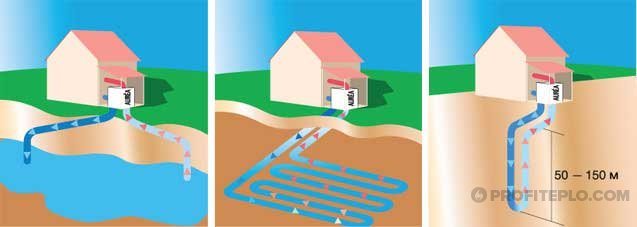
Types of ground source heat pumps
Heating a house with the energy of the earth requires extensive work on the installation of the system, but it is an environmentally friendly way to get almost free thermal energy. To heat a house, you will need a small amount of electricity required for the system to function.
Costs and payback prospects
The costs of equipment and its installation during the construction of geothermal heating depend on the capacity of the unit and on the manufacturer. Everyone chooses a manufacturer, guided by their own considerations and information about the reputation and reliability of a particular brand. But the power depends on the area of the room to be serviced.
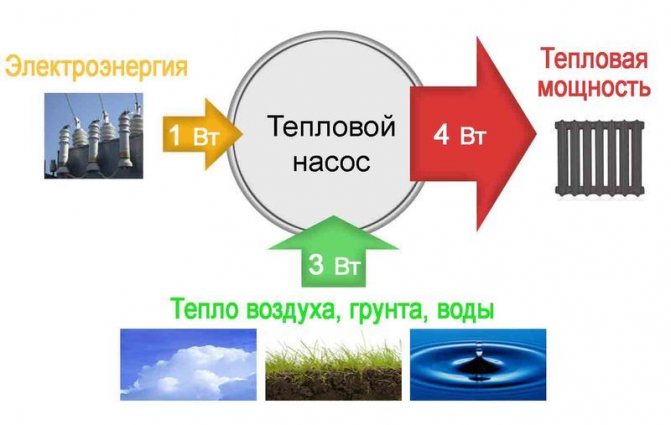

This figure summarizes the benefits of a geothermal heating system. It is this ratio of incoming and outgoing energy that allows the system to quickly pay off at first, and then save money for its owner.
If we take into account the power, then the cost of heat pumps fluctuates in the following ranges:
- for 4-5 kW - 3000-7000 conventional units;
- for 5-10 kW - 4000-8000 conventional units;
- for 10-15 kW - 5000-10000 conventional units.
If we add to this amount the costs that are needed for the installation work (20-40%), then we will get an amount that for many will seem absolutely unrealistic. But all these costs will pay off in a very reasonable time. In the future, however, you will have to pay only a minor cost of electricity required to operate the pump. And it's all!
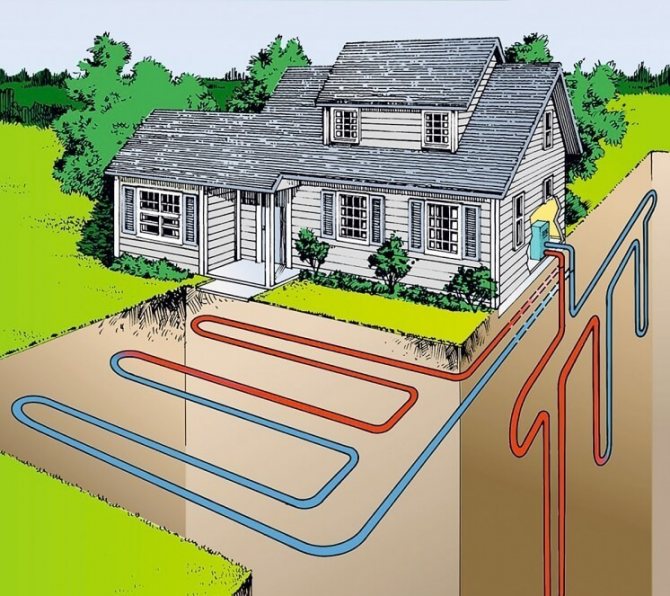

Due to the insufficient efficiency of geothermal systems for heating residential buildings, they are used as an addition to the main heating networks or are built in combination with two or more heat exchangers.
As practice shows, geothermal heating is especially beneficial for houses with a total heated area of 150 sq. meters. In five to eight years, all the costs of arranging heating systems in these houses are fully paid off.
Operating principles of geothermal heating
Heating from the energy of the earth is successfully used in various climatic zones: the systems are capable of operating in both the southern and northern regions.
In the course of its operation, a geothermal installation uses such a physical property of some fluids as the ability to evaporate, which leads to cooling of the surface. It is this phenomenon that underlies the operation of refrigeration equipment.
The principle of operation of geothermal heating is a reverse-run cooling process. This is how air conditioners work, capable of not only cooling, but also heating the air in the room.
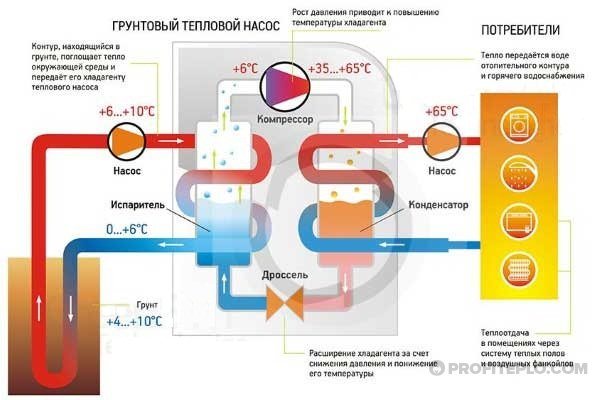

How the heat pump works
However, air conditioning units have limited functionality - they cannot function at temperatures below -5 ° C. And the geothermal system is able to provide heating of the house regardless of the air temperature on the surface. This is due to the fact that in the environment from which it takes heat energy, stable temperature conditions are naturally maintained.
Several historical facts
When the oil crisis broke out in the 70s of the last century, a burning need arose in the West for alternative energy sources. It was at this time that the first geothermal heating systems began to be created. Today they are widespread in the United States, Canada, and Western European states.
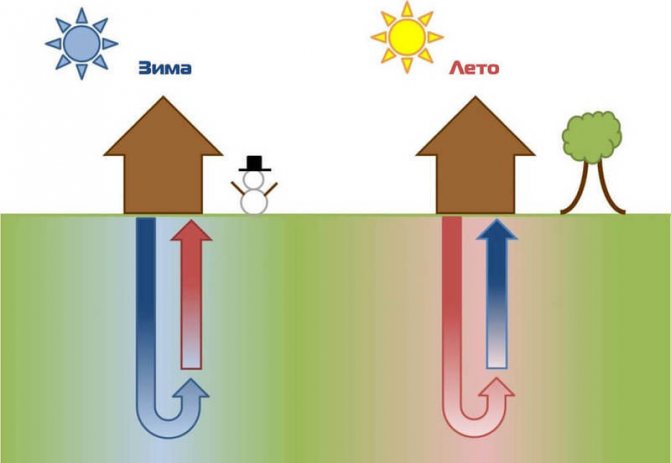

When we mention geothermal energy sources, we always imagine a valley of geysers or volcanoes, but the sources we need are much closer. And they will help us keep warm in winter and cool in summer.
For example, in Sweden, the water of the Baltic Sea is actively used, the temperature of which is + 4 degrees. In Germany, the introduction of geothermal heating systems is even sponsored at the state level. Pauzhetskaya, Verkhne-Mutnovskaya, Okeanskaya and other geothermal power plants operate in Russia. But there are very few facts about the use of the Earth's energy in our private sector.
Geothermal heating system device
Geothermy (the science of the thermal state of the Earth) made possible the practical use of thermal energy that the earth's crust receives from the hot magma in the center of the planet.
A specially designed heat pump for heating a house is installed on the surface, and a heat exchanger is mounted in the ground or at the bottom of the reservoir. Thermal energy is "pumped out" to the surface and allows you to heat the coolant in the heating circuit of a house or non-residential facility.
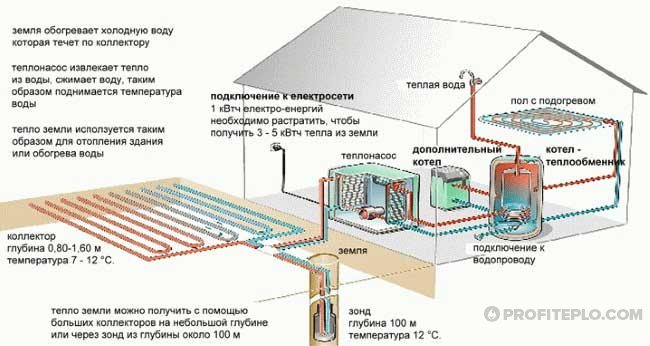

How is the heating process
Geothermal heating of a private house is a cost effective option. If you use the energy of the earth to heat a house, then for every kilowatt of electricity required for the operation of the equipment, there are 4 to 6 kW of useful thermal energy obtained from the bowels of the planet.
In comparison with the operation of the air conditioner, we will see that during its operation, more than 1 kW of electricity is required to obtain 1 kW of thermal energy. This is due to the inevitable losses for the conversion of one energy into another, etc.
It is very profitable to heat a residential building using the thermal energy of the earth's interior, but the payback period for equipment and installation costs will take some time.
Using the heat of the earth to heat a house does not require the installation of a traditional boiler to heat the coolant.
In this case, the system consists of three components
:
- heating circuit - geothermal source of thermal energy;
- heating circuit inside the house - low-temperature radiator or floor;
- pumping station - a heat pump for pumping heat energy into the heating circuit from the heating circuit in the soil or under water.
A geothermal heating system can also be used to heat greenhouses, ancillary buildings, pool water, garden paths, etc.
Advantages and disadvantages
pros
- An almost inexhaustible and stable source of energy;
- Manufacturers of such systems call such heating free for the owner. But this is not the case, since we must not forget about the cost of electricity. However, it is cheaper than traditional heating systems;
- Geothermal heating can be used in almost any region, with the exception of the northern ones;
- Geothermal heating systems do not have harmful emissions;
- They take up little space in the house (about the size of a refrigerator);
- It is possible to configure the operation of the units for both heating and cooling;
- If necessary, the geothermal installation can be integrated into the heating system of a house with a gas or electric boiler.
Minuses
- Long payback period;
- A large amount of initial investment in the purchase and installation of a geothermal heating system.
Equipment for the arrangement of geothermal heating
Geothermal equipment for deep heating systems allows accumulating thermal energy extracted from the environment and transferring it to the heat carrier in the heating circuit.
The list of equipment for heating with heat from the earth includes
:
- Evaporator. The device is located at a depth, and it serves to absorb thermal energy located in geothermal waters or soil.
- Capacitor. Allows to bring the temperature of the antifreeze to the value required for the functioning of the system.
- Heat pump. Provides circulation of antifreeze in the heating circuit, controls the operation of the geothermal installation.
- Buffer tank - a container for collecting heated antifreeze. Allows you to transfer thermal energy of the earth's interior to the coolant. The tank through which the coolant passes is equipped with a coil-shaped heat exchanger. Heated antifreeze moves along it, giving off heat.
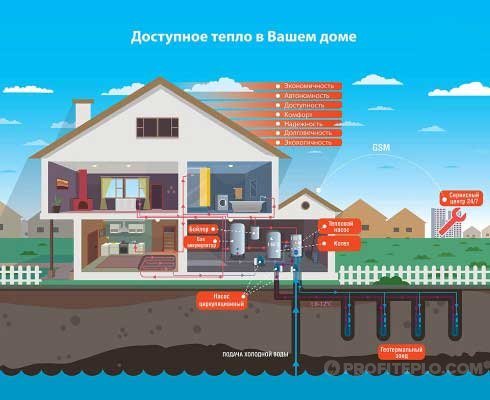

Heat pump device diagram
System installation
Geothermal heating of a country house at the stage of arrangement requires a solid investment. The high total cost of the system is largely due to the large amount of land work associated with the installation of the heating circuit.
Over time, the financial costs pay off, since the thermal energy used during the heating season is extracted from the depths of the earth with minimal energy consumption.
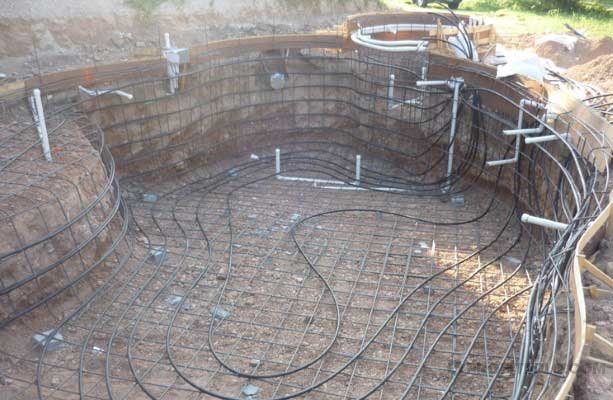

Installation of a horizontal heat exchanger for a geothermal heating system
To provide heating of the house with the heat of the earth, installation of the system
:
- the main part should be located underground or at the bottom of the reservoir;
- in the house itself, only sufficiently compact equipment is installed and a radiator or floor heating circuit is laid. The equipment located inside the house allows you to regulate the heating level of the coolant.
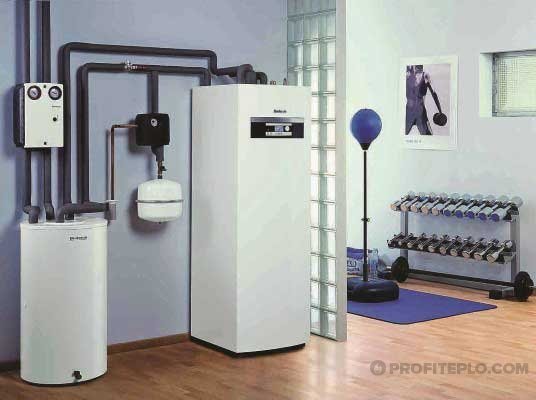

What does geothermal equipment look like in a home
When designing heating using the heat of the earth, it is necessary to decide on the installation option for the working circuit and the type of collector.
There are two types of collectors
:
- Vertical - plunges into the ground for several tens of meters. To do this, at a short distance from the house, you need to drill a number of wells. A contour is immersed in the wells (the most reliable option is cross-linked polyethylene pipes).
- Disadvantages: Large financial costs for drilling several holes in the ground with a depth of 50 meters.
Advantages: The underground pipe location at a depth where the ground temperature is stable, provides a high efficiency of the system. In addition, the vertical collector takes up a small area of land.
- Horizontal.The use of such a collector is allowed in regions with warm and temperate climates, since the depth of soil freezing should not exceed 1.5 meters.
- Disadvantages: The need to use a large area of the site (the main disadvantage). After laying the contour, this piece of land cannot be used for a garden or vegetable garden, since the system works with the release of cold when transporting refrigerant, which will cause the roots of the plants to freeze.
Benefits: Cheaper land work that can even be done on your own.
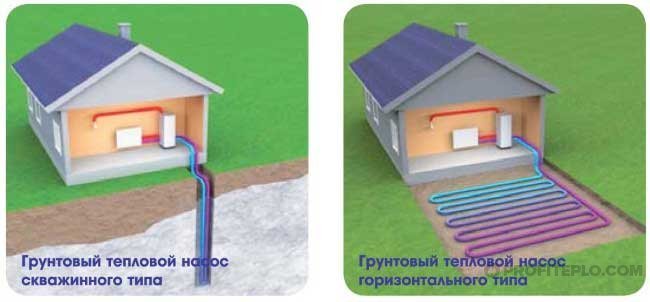

Horizontal and vertical collector type
Geothermal energy can be obtained by laying a horizontal geothermal circuit at the bottom of a frost-free reservoir. However, this is difficult to implement in practice: the reservoir can be located outside the private territory and then the installation of the heat exchanger will need to be coordinated. The distance from the heated object to the reservoir should be no more than 100 meters.
Important! The ambient temperature of the collector must not fall below + 5 ° C. The upper part of the collector in contact with the freezing soil must be protected with thermal insulation to avoid loss of thermal energy.
Video about the principles and results of operation
If it is easier for you to perceive visual information, then this video will allow you to see with your own eyes exactly how the geothermal system functions, as well as learn more about who and why this type of heating is beneficial.
We invite you to watch a short video in which the owner of a horizontal subsurface collector will tell you about his impressions of its operation. In addition, by watching this video, you will learn about the running costs associated with operating a geothermal heating system.
Each owner of a private house chooses for himself whether to buy the services of resource-supplying organizations or rely only on himself. In doing so, he is guided by a whole list of considerations. The task that we have set for ourselves is not to push you to a ready-made conclusion, but to share information about the options for solving the problem before you. published
P.S. And remember, just by changing your consumption - together we are changing the world! © econet

